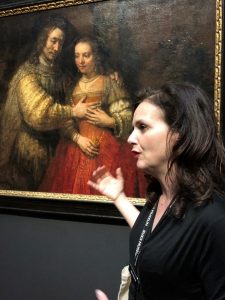
The portrait prompts us to remember: Human connection is a subject much broader than eye contact. What the two are thinking isn’t particularly important, although we might wonder. The artist reminds us that even as we all live in our own inner worlds, at the same time, we are all connected. It’s a moment that transcends the centuries.
Rembrandt painted in 1665 The Jewish Bride, although scholars say it is neither of a bride nor Jewish couple. Their names and relationship are anonymous. Yet, Van Gogh said it was his favorite work of art. He said he’d give up ten years of his life to sit with only bread and water to take in the magic of the moment captured in this painting. In some ways, the lack of historical documentation accentuates the tenderness of the moment. It hangs in Amsterdam’s Rijksmuseum.
At a private event there recently, this special painting and I met one another. It was my first time to consider the Dutch master. For example, never before had I associated Van Gogh’s brilliant colors and movement with the somber palette of Rembrandt’s era. Loving the brilliant and eschewing dark colors, I often dismissed Rembrandt. That is, until I was there, in person. With the help of a docent, my untrained eyes began to see for myself what no photograph could capture.
Reproductions of Rembrandt’s work don’t express, for example, how what appear to be meticulously painted details are, in reality, skillful flourishes of thick paint. The paint captures light in such a way as to create specifics of dress, hands, and expression. From a few feet away, his technique provides the impression of exquisite detail. Up close, the details disappear into gooey globs. In the 1500’s, Rembrandt used impressionistic manipulations of paint and light centuries ahead of the beloved 19th century art revolution. His artistry captured emotions almost impossible to express otherwise. Maybe, you already know all this. I was surprised by my discoveries.
Besides providing an art-history lesson, what’s relevant for you, today about my painterly experience? What does all this remind us about communication, speaking, and daily leadership? For starters, consider these three ideas:
1.No technology can accurately capture the many subtle exchanges of thought and feeling that happen during an in-person experience when people are in physical proximity. As helpful as Zoom (my favorite video conference tool) and other technology may be, person-to-person influences and changes our lives in ways that two-dimensional formats cannot.
2.As much as we think there’s something new under the sun, the greater truth is that what appears new is built on the foundations and footsteps of others. This is as true for innovations in business, technology, science, and art as it is for ideas that propel mankind forward. All have a history and a context. We are better, smarter, less arrogant and entitled moving forward, when we acknowledge and understand where we are relative to where we have been. Great communication such as principles of Center Stage help us find context and meaning that our eyes may not be trained to see.
3.Endless curiosity and learning are as close as a panacea to your personal problems and all the problems we face in this world as a solution gets. Great communication, the purpose of Center Stage, and great art all encourage us to reach beyond the status quo and expand our capacity to create answers to the endless challenges of our lives.
Perhaps, you have other ideas? I hope you share them.
